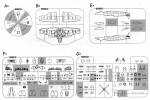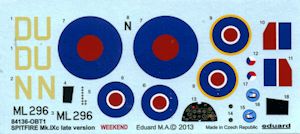
Eduard 1/48 Spitfire IXc (late)
| KIT #: | 84136 |
| PRICE: | $25.99 SRP |
| DECALS: | One option |
| REVIEWER: | Scott Van Aken |
| NOTES: | Weekend Edition |

| HISTORY |
In the early months of 1942, with the clear superiority of the Focke Wulf Fw 190 over the Spitfire VB, there was much pressure to get Spitfires into production using the new two-stage supercharged Merlin 61 engine. In September 1941 the Spitfire Mk III prototype N3297 had been converted by Rolls-Royce at their Hucknall plant to take a Merlin 60, which had been specifically designed for use in the Wellington Mk VI high altitude bomber.
The performance increase was described as a "quantum leap" over that of the Mk VB and another Spitfire airframe, R6700 was modified to take the new engine. Although design work on the Mk VII and VIII series was under way, these would take over a year to get into production and a counter to the Fw 190 was urgently needed. The Air Ministry made the decision that Mk VC airframes should be converted to take the more powerful engine and, as a result, many of the early IXs were converted Mk VCs which did not have any of the refinements which later appeared. These could be identified by the Type C wing with the large double blisters over the inner cannon bays and the identification light on the fuselage spine, behind the aerial mast. The elevator horns were also smaller in size than that of most Mk IXs which had larger horn balances. The first IX was a modified VC AB505, which was tested by the Air Fighting Development Unit (AFDU) in April 1942. The report said;
The performance of the Spitfire IX is outstandingly better than the Spitfire V especially at heights above 20,000 feet. On the level the Spitfire is considerably faster and climb is exceptionally good. It will climb easily to 38,000 feet and when levelled off there can be made to climb in stages to above 40,000 feet by building up speed on the level and a slight zoom. Its manoeuvrability is as good as a Spitfire V up to 30,000 feet and above is very much better. At 38,000 feet it is capable of a true speed of 368mph and is still able to manoeuvre well for fighting.
Although the Mk IX's airframe did not have the aerodynamic and strength improvements, or the modified control surfaces of the Mk VII and VIII, the Mk IX still proved to be an effective counter to the Focke Wulf Fw 190.
In September 1942, the "High Altitude Flight" was set up at RAF Northolt to counter the threat of the high altitude Junkers Ju 86 R bombers. Two Spitfire IXs converted from VCs were stripped of armour, the .303 Brownings and other equipment and repainted in a lightweight PRU blue finish. One of them intercepted a Ju 86R at over 40,000 feet (12,000 m).
Production of the Mk IX finished at Supermarine in June 1943, with production continuing exclusively at the Castle Bromwich factory. Several major and large numbers of minor improvements were progressively introduced to Mk IXs, some of which were used on other Spitfire variants.
The Merlin 61 was phased out early in 1943 in favour of the Merlin 63 and 63A. The new engine had increased power resulting from engine improvements and engine limitations of +18 lbs./sq.in and 3,000 rpm (5 minute combat). During the second half of 1943, production of the Merlin 63 powered F Mk IX was discontinued in favour of the Merlin 66 powered LF Mk IX. Early production Spitfire IXs suffered from vapour locks in the fuel lines resulting from fuel evaporating if the aircraft was parked in direct sunlight. As a result of this the gun-camera was moved from the port wingroot to the starboard wingroot and a fuel cooler, fed by a small round air-intake was fitted in its place. This fuel cooler was also fitted to early PR Mk XIs.
Production of the LF Mk IXs, frequently referred to as the Spitfire IXB, initially ran in parallel with the Merlin 63 powered Marks. This version first became operational in March 1943 with the Biggin Hill Wing, comprised at the time of 611 and 341(Free French) Squadrons. This type was by far the most produced of the Spitfire IX variants, with over 4000 built. The maximum power of the Merlin 66 was 1,720 hp (1,280 kW) at 5,750 ft (1,283 kW at 1,752 m) and the maximum speed of the Spitfire LF IX was 404 mph (650 km/h) at 21,000 feet (6,400 m). The Merlin 66 introduced a new Bendix-Stromberg injection carburettor, which replaced the earlier S.U float carburettor.
The H.F IX was powered by the specialized high altitude Merlin 70 and entered service in the Spring of 1944. Serial listings show that the HF Mk IX was produced in relatively limited numbers when they were required, with priority being given to versions rated for low and medium altitudes. Maximum power of the Merlin 70 was 1,710 hp (1,280 kW) at 11,000 ft (1,275 kW at 3,353 m): maximum speed of the Spitfire HF.IX was 405 mph (652 km/h) at 25,400 feet (7,700 m) at an all-up weight of 7,320 lbs (3,320 kg).
Also introduced in early 1944 was a new Mark II Gyro gunsight. This gunsight calculated the correct angle of deflection to use when leading the target. Its introduction doubled the effectiveness of RAF gunnery and was a major factor in Allied air superiority.
The capacity of the main fuel tanks was 48 gal for the upper tank and 37 gal for the lower, for a total internal capacity of 85 gal. Jettisonable "slipper tanks" of 30, 45 or 90 gal could be carried under the centre-section. As an alternative a cylindrical 50 gal drop tank, adapted from those carried by long range Hawker Typhoons, could be carried on the fuselage bomb rack used on most Mk IXs of the Second Tactical Air Force. To further increase the combat radius some late production Mk IXs were fitted with additional internal self-sealing fuel tanks in the rear fuselage: the upper tank carried 41 gal and the lower 34 gal. When both were full this enabled a ferry range of over 1,200 miles (1,900 km), although they made the aircraft unstable in flight and only straight flight and gentle manoeuvres at low altitudes were recommended by the pilot's manual. The pilot was also warned to avoid instrument flying whenever possible.
Late production Mk IXs, in common with Mk XVIs introduced a new upper engine cowling which incorporated a distinct bulged top surface; this design was adopted for the Mk XVI to allow for the modified intercooler of the Packard Merlin 266, which had an integral header tank.
| THE KIT |
 When it comes to most Eduard kits, I like to wait until all the hype is over
and they come out with the significantly less expensive Weekend Edition. Now
this version is devoid of multiple decal options, masks, resin bits and photo
etch. Sometimes this causes issues as with some other similar kits, the photo
etch bits are required and having them missing makes for an incomplete model.
This does not seem to be the case with this one.
When it comes to most Eduard kits, I like to wait until all the hype is over
and they come out with the significantly less expensive Weekend Edition. Now
this version is devoid of multiple decal options, masks, resin bits and photo
etch. Sometimes this causes issues as with some other similar kits, the photo
etch bits are required and having them missing makes for an incomplete model.
This does not seem to be the case with this one.
Parts are very nicely molded and looking at the sprues, it seems that one is not limited to doing a late Mk.IXc. One cannot do a very late version as the Mk.II gun sight is not included. The kit is supposed to be built with the pointy rudder, the later elevators, the longer carb intake, standard wing tips and the fishtail exhaust. However, the kit has on the 'do not use' diagram, the more rounded rudder, early elevators, short carb intake, clipped wing tips and round exhaust. Having all of these bits included only makes this kit much more flexible when using aftermarket decals. The kit uses five spoke wheels.
Eduard has provided a very nicely detailed interior for you, that only needs
belts to be most satisfactory. Fortunately, most of us have etched belt sets for
use on other kits so one simply uses those. The kit can be built with the canopy
open or closed and for the latter option, some surgery will need to be done.
Eduard seems to build their kits for everything open. Moving to the wings, the
ailerons are separate and the flaps molded up. This is correct as lowered flaps
only cause the engine to overheat so were put in the 'up' position once the
plane had landed. Believing that more parts are better than fewer, there are no
less than seven inserts for each wheel well plus a forward wing spar. The other
bit that can be modeled lowered are the exhaust flaps for the wing coolers. Each
of these has its own actuating rod.
can be modeled lowered are the exhaust flaps for the wing coolers. Each
of these has its own actuating rod.
Instructions are quite nicely done with the usual Gunze color references, something not too useful in the US where Gunze is no longer imported. The single set of markings for the box art plane of 312 (Czech) Squadron are very nicely done and include all the appropriate stencils.
| CONCLUSIONS |
I've read a number of articles on the Profipak version and everyone seems to like it a great deal. Nice thing about this boxing is that it seems one can also do an early Mk IXc and thanks to the huge number of aftermarket decals for the Spit IX, being able to find something a bit different shouldn't be much of a problem.
| REFERENCES |
http://en.wikipedia.org/wiki/Supermarine_Spitfire_%28late_Merlin-powered_variants%29
April 2014 Thanks to me for getting this on sale. If you would like your product reviewed fairly and fairly quickly, please
contact
the editor or see other details in the
Note to
Contributors.